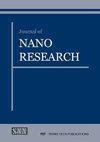可重复使用的嗜盐细菌附着醋酸纤维素纳米纤维网去除Cr (VI)和活性染料
IF 1
4区 材料科学
Q4 MATERIALS SCIENCE, MULTIDISCIPLINARY
引用次数: 1
摘要
研究了耐盐柠檬酸球菌(Citricoccus sp.)对六价铬(Cr (VI))和活性蓝(RB)的去除率在初始pH、接触时间、温度、NaCl浓度和不同污染物浓度等条件下的变化。本研究采用静电纺丝法制备了柑橘黏附的醋酸纤维素(CA)纳米纤维网(NfW),进一步提高了脱除率。原始CA-NfW的Cr (VI)去除率为11.39±0.002%,而附着CA-NfW的Cr (VI)去除率为39.19±0.43%。因此,细菌附着的CA-NfW对Cr (VI)的去除能力明显高于原始CA-NfW。此外,重复使用试验表明,细菌附着CA-NfW可以在脱色和Cr (VI)去除步骤中至少连续使用三次。RB脱色率为31.5±0.2%,Cr (VI)去除率为5.63±0.30%。这些结果是有希望的,因此表明细菌附着的CA-NfW由于其通用性和可重复使用性,可用于去除含Cr (VI)和活性染料的废水。本文章由计算机程序翻译,如有差异,请以英文原文为准。
Reusable Halophilic Bacteria Attached Cellulose Acetate Nanofiber Webs for Removal of Cr (VI) and Reactive Dye
Hexavalent Chromium (Cr (VI)) and Reactive Blue (RB) removal efficiencies of halotolerant Citricoccus sp. were examined for different parameters such as initial pH, contact time, temperature static/shaking, NaCl concentration, and different pollutant concentrations. In this research, Citricoccus sp. attached cellulose acetate (CA) nanofiber webs (NfW) were produced by electrospinning method to improve the removal yield even further. The Cr (VI) removal yield was calculated as 11.39 ± 0.002% for the pristine CA-NfW, whereas it was 39.19 ± 0.43% for bacteria attached CA-NfW. Therefore, the Cr (VI) removal capacities of bacteria attached CA-NfW were significantly higher than that of pristine CA-NfW. In addition, reusability tests revealed that bacteria attached CA-NfW can be used at least three successive times in decolorization and Cr (VI) removal steps. The decolorization rate of the RB and Cr (VI) removal yield was found to be 31.5 ± 0.2% and 5.63 ± 0.30%, respectively. These results are promising and therefore suggest that bacteria attached CA-NfW could be applicable for the removal of wastewater containing Cr (VI) and reactive dye due to their versatility and reusability.
求助全文
通过发布文献求助,成功后即可免费获取论文全文。
去求助
来源期刊

Journal of Nano Research
工程技术-材料科学:综合
CiteScore
2.40
自引率
5.90%
发文量
55
审稿时长
4 months
期刊介绍:
"Journal of Nano Research" (JNanoR) is a multidisciplinary journal, which publishes high quality scientific and engineering papers on all aspects of research in the area of nanoscience and nanotechnologies and wide practical application of achieved results.
"Journal of Nano Research" is one of the largest periodicals in the field of nanoscience and nanotechnologies. All papers are peer-reviewed and edited.
Authors retain the right to publish an extended and significantly updated version in another periodical.
 求助内容:
求助内容: 应助结果提醒方式:
应助结果提醒方式:


